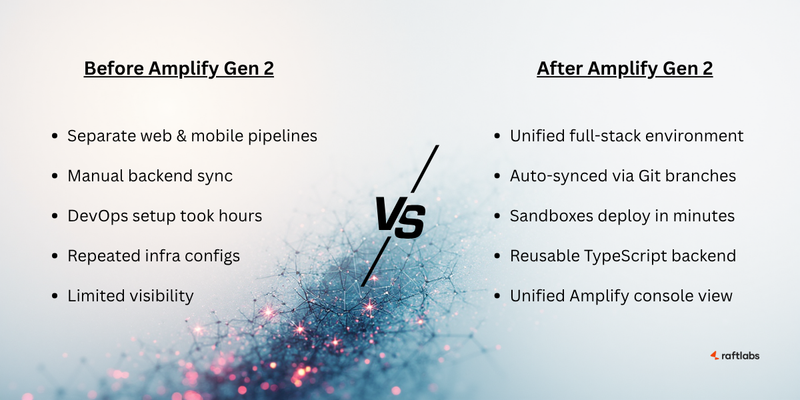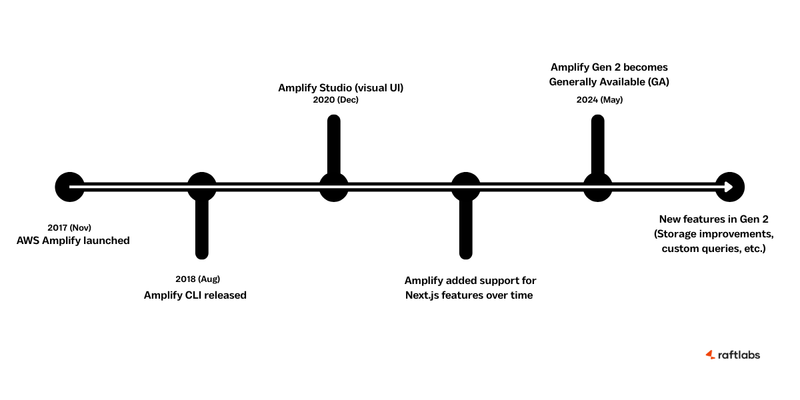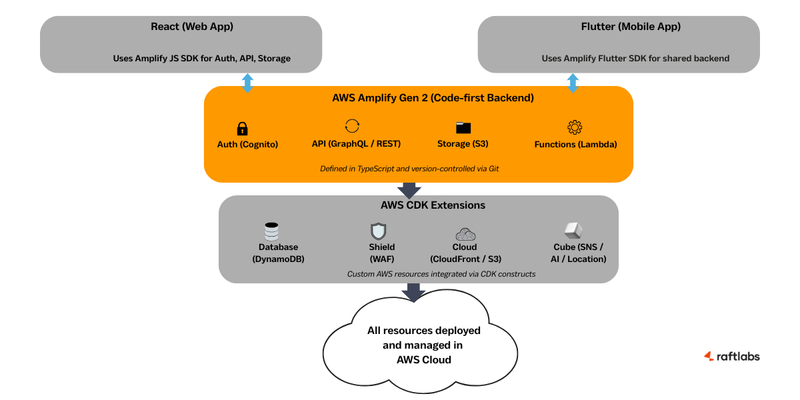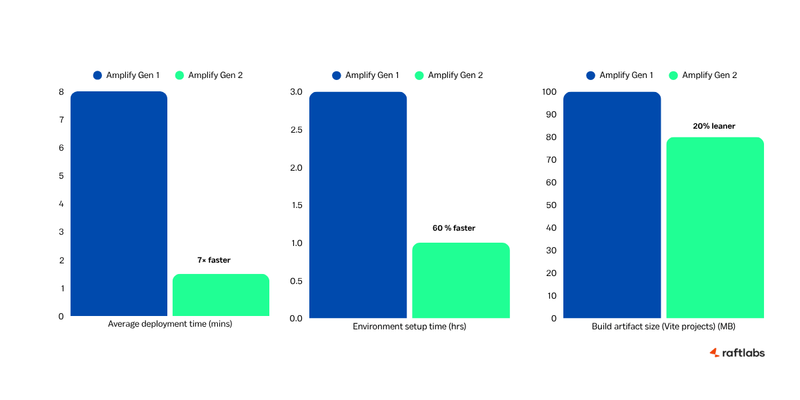
AWS Amplify Gen 2 in Action: What We Learned About Speed and Scalability
- Rahul Retnan
![Rahul Retnan]()
- Development
- Last updated on
Introduction
We’ve been building software for almost a decade, shipping web, mobile, and AI apps for startups and enterprises across the world. AWS has been one of our most trusted technologies during this journey, and it shows up in almost every project we deliver.
For those unfamiliar with it, AWS (Amazon Web Services) is one of the world’s leading cloud platforms. It powers everything from hosting and databases to AI and developer tools, forming the backbone of many modern, scalable apps.
When AWS announced Amplify Gen 2, we wanted to see whether it could simplify full-stack development while keeping the flexibility and speed our clients expect.
So we tried it on a real project recently. We used React for the web app development, Flutter for the mobile app development, and Amplify Gen 2 for the backend. The results were encouraging in many areas, and they also revealed a few places where we had to adjust our approach.
Amplify Gen 2 is ideal for full-stack development where you want to build both web and mobile apps with a single backend.
It works well for consumer-facing platforms like e-commerce apps, loyalty programs, or booking systems, as well as internal tools and MVPs that need to be launched quickly.
Teams can focus on building features while Amplify handles much of the infrastructure, though highly customized or enterprise-grade systems may still require extensions using AWS CDK.
In this article, we share exactly what changed for our team. You will see where Amplify Gen 2 shines, where it falls short, and how to decide if it fits your next build.
Who should read this
If you’ve ever spent hours fixing CI/CD pipelines, managing environments, or syncing web and mobile teams, you’ll relate to this.
This article is for
Startup founders building products on AWS
Agencies handling multiple web or mobile projects
Developers who want to move faster without heavy DevOps work
What you will get
Before we go deeper, here’s what you can expect from this article. It’s not a technical walkthrough but a real-world look at how Amplify Gen 2 changes the development experience when you build for both web and mobile.
You’ll find a plain-language explanation of what’s new in Amplify Gen 2, along with an easy-to-follow Amplify Gen 2 vs Gen 1 comparison that highlights the key differences in workflow, speed, and developer experience.
We’ll walk you through our experience using React and Flutter, showing what actually improved and what needed extra work.
And finally, we’ll share our honest take on when Amplify Gen 2 is a great fit, when you might need to extend it with CDK, and when another setup could serve you better.
By the end, you’ll have a clear sense of how Amplify Gen 2 fits into modern app development, what it does well, where it still struggles, and whether it’s the right choice for your next project.
The Business Context: Why We Moved to Amplify Gen 2
Before Amplify Gen 2, our teams were managing separate environments for web and mobile projects. Backend updates often meant hours of manual syncing. CI/CD pipelines were fragile. Adding new developers slowed things down instead of speeding them up.
We needed something that could:
Unify web and mobile environments
Reduce DevOps overhead
Bring type safety from backend to frontend
Support rapid iteration without losing control
Amplify Gen 2 checked all those boxes. It offered a code-first, Git-based workflow that aligned perfectly with how our developers already worked.
For growing product teams, every friction point adds up and removing them translates directly into faster release cycles and happier developers.

What is AWS Amplify Gen 2 (and Why It Matters Now)
For anyone new to the ecosystem, AWS Amplify Gen 2 is a modern full-stack development framework that lets you define your entire backend using TypeScript.
It combines the simplicity of infrastructure-as-code with a great developer experience. Unlike Gen 1, which depended on the CLI and AWS Console, Gen 2 follows a code-first model.
You can define Auth, Data, Storage, and Functions directly inside your repository using TypeScript files. Every configuration stays version-controlled, type-safe, and ready to deploy with a single command.
This shift reflects how modern development is evolving, with TypeScript-first, Git-based, and code-driven workflows that give developers more control while keeping projects consistent across teams.

What Amplify Gen 2 Brings to the Table
Before we share our experience, it helps to understand what really sets Amplify Gen 2 apart. The upgrade is not just about new commands or a fancier console. It changes how developers work with AWS from the ground up, focusing on speed, flexibility, and cleaner code.
1. A Code-First, TypeScript-First Developer Experience
Amplify Gen 2 moves away from the old console-based setup and introduces a TypeScript-native workflow. You define backend features such as Auth, Data, Storage, and Functions through files like amplify/auth/resource.ts. This brings IntelliSense, type hints, and compile-time checks right into your editor.
The result is faster development and fewer surprises. Everything feels predictable because each part of the backend is strongly typed and lives inside your codebase. It gives developers more confidence and control while reducing the need to switch between tools.
2. Faster Iteration with Per-Developer Cloud Sandboxes
Each developer gets a separate cloud sandbox. This means no more overwriting each other’s changes or waiting for shared environments to deploy. Updates go live much faster, sometimes up to eight times quicker than before, and everyone can test safely in their own space.
This setup makes collaboration smoother and keeps productivity high, especially in growing teams.
3. Branch-Based Deployment and Unified Console
With Amplify Gen 2, every Git branch becomes its own full-stack environment. You can create staging, feature, or production builds just by pushing a branch. The new Amplify console brings everything together in one place, from managing secrets to monitoring builds and data.
It makes environment management more transparent and removes the typical overhead that comes with multi-branch workflows.
4. Deep CDK Integration
For teams that need more than Amplify’s ready-made modules, Gen 2 works directly on top of the AWS CDK. You can extend it with any AWS service such as WAF, AI tools, or S3 event triggers without switching frameworks or breaking your setup.
This flexibility helps teams move quickly in the short term and still plan for long-term scalability.
Amplify Gen 2 is a reliable part of a growing architecture that can evolve with your product.
Real-World Use Case: How We Used It in a Client Project
After exploring what Amplify Gen 2 brings to the table, we decided to use it in one of our client projects to see how it performs in the real world. The project was a multi-platform eCommerce app built with a React-based admin portal for internal teams and a Flutter mobile app for customers. Both needed to share a single, consistent backend.
We used Amplify Gen 2 to:
Set up secure authentication using Cognito
Deploy GraphQL APIs for real-time data synchronization
Integrate S3 storage for media handling
Extend the setup with CDK for custom business logic
This approach gave us a unified backend that connected both apps seamlessly. It also reduced our infrastructure setup time by nearly 60 percent. Deployment pipelines became a one-command process, making releases faster and more predictable.
For us, this mattered because both web and mobile teams could work independently without worrying about backend conflicts or mismatched environments. Everything stayed in sync, version-controlled, and easy to maintain.

Pro tip: Use Vite for a smoother Amplify build process. It helps keep your builds lightweight and deployment times shorter.
Developer POV vs Business POV
What stood out the most in this project was how Amplify Gen 2 managed to keep both sides of the equation happy. Developers got a cleaner, faster, and more predictable workflow, while the business gained the speed and reliability needed to deliver projects on time.
Usually, tools lean too far in one direction. Either they make developers happy but increase delivery risk, or they speed up shipping at the cost of maintainability. Amplify Gen 2 found a rare middle ground.
| Developer Wins | Business Wins |
|---|---|
| Type-safe backend setup | Faster release cycles |
| Git-based environments | Lower DevOps overhead |
| CDK extensibility | Easier scalability planning |
| Code-first workflow | Predictable infrastructure cost |
This alignment mattered to us. A tool is only valuable when it works for both teams in the long run.
Amplify Gen 2 helped us deliver client apps faster while keeping our infrastructure stable and maintainable. It gave our developers more freedom to build, and our clients more confidence that the systems we deploy will scale smoothly.
After seeing how Amplify Gen 2 aligned both developer goals and business needs, we started to notice the real benefits in daily work. The small improvements added up quickly. From faster builds to cleaner handoffs, the overall experience felt smoother and more connected.
1. Rapid Development with Type Safety
Setting up Auth, Storage, APIs, and Lambda functions became noticeably faster. TypeScript made everything predictable because errors appeared during development instead of in production. This gave our developers more confidence to experiment and move quickly, knowing that each part of the stack stayed type-safe and consistent.
2. Effortless Integration Across Platforms
Using Amplify Gen 2 helped both our web and mobile teams work in sync. The shared configuration meant React and Flutter apps could rely on the same backend setup. It reduced context switching, made debugging simpler, and kept releases on schedule.
3. Simplified CI/CD and Environment Management
The Git-centric structure was one of the biggest time savers. Every branch worked as a separate environment for staging, testing, or production. Setting up firewalls, managing secrets, and deploying updates all felt straightforward through the Amplify Console. It reduced the usual DevOps friction we used to face.
4. Custom Infrastructure Flexibility
When we needed something outside Amplify’s built-in tools, CDK integration gave us room to grow. For example, we added an extra caching layer without disrupting any existing setup. The transition between Amplify and CDK felt natural, allowing us to stay flexible while keeping everything connected under one system.
All of this combined to create a development experience that felt faster, cleaner, and far easier to maintain. Amplify Gen 2 didn’t just help us ship faster. It made the entire process of building and scaling apps more enjoyable for our team.
Performance Snapshot
All the workflow improvements we noticed were not just about a better developer experience. They also showed up clearly in our Amplify Gen 2 performance metrics.
The difference between Amplify Gen 1 and Gen 2 was easy to measure once we looked at our internal benchmarks.
Here’s a quick comparison from our recent projects:
| Metric | Before (Gen 1) | After (Gen 2) | Improvement |
|---|---|---|---|
| Average deployment time | ~8 min | ~1.5 min | 7× faster |
| Environment setup | ~3 hrs | < 1 hr | 60% faster |
| Build artifact size (Vite projects) | 100 MB | 80 MB | 20% leaner |
While the numbers can vary slightly depending on the project size and framework, the overall pattern remains the same. Amplify Gen 2 consistently reduces setup time, speeds up deployments, and keeps builds lighter.

For our team, this meant less time waiting for builds and more time focusing on product work. The faster feedback loop also helped us iterate quickly, catch issues early, and ship updates with confidence.
Challenges and Limitations
The improvements with Amplify Gen 2 were impressive, but like any new tool, it came with its own set of challenges. Some were small adjustments, while others required a bit more time and planning to work around.
1. Learning Curve
Amplify Gen 2 is not plug and play. The file-based conventions, CDK syntax, and code-first backend setup take some time to get used to. Once the structure starts to make sense, productivity improves quickly, but onboarding new team members still takes effort.
2. Artifact Size Issues with Next.js
One of the biggest hurdles we faced was managing build artifact sizes. Our Next.js projects sometimes went beyond the 220 MB SSR limit, which slowed down deployments. In comparison, our Vite projects stayed under 100 MB and deployed much more smoothly.
Pro tip: Use Vite for a smoother Amplify build process. It keeps builds lighter and deployment times shorter.
3. SSR and Next.js Feature Gaps
Amplify Gen 2 supports many Next.js features such as SSR, SSG, i18n, and the App Directory. However, it still lacks support for a few advanced capabilities:
Edge API Routes
On-demand ISR
Streaming responses
Certain middleware use cases
For projects that rely heavily on these features, you may encounter limitations that require alternative setups or custom CDK extensions.
Even with these challenges, Amplify Gen 2 offered enough flexibility to adapt. The learning curve felt like a one-time investment, and most issues had workarounds once we understood the platform better.
Community Insights and Our Take
After working through some of the challenges ourselves, we looked to the broader developer community to see if others were facing the same issues. It turns out we were not alone. The Amplify Gen 2 community has been quite active, sharing both appreciation and constructive feedback.
1. Common Frustrations Around GraphQL and Authorization
One developer summarized it well:
“I appreciate having my own infrastructure stack that I can easily delete, but the forced use of GraphQL with poorly documented authorization principles makes it harder than it should be.”
We could relate to this experience. The learning curve, especially around complex authentication flows, can feel steep at first. However, once the team understands the conventions and structure, productivity starts to climb fast.
2. Documentation Gaps and Workarounds
Another recurring point in the community is the lack of comprehensive documentation for advanced use cases. We ran into this too. Our way around it was to create strong internal documentation for our team.
We used short Loom videos, internal readme files, and quick reference guides to capture what worked for us. This small habit made onboarding and collaboration much smoother.
3. Shared Learning from the Community
Many developers also share best practices and small fixes across GitHub issues, Reddit threads, and AWS forums. This informal community support often filled in the gaps where official documentation stopped short. It is one of the underrated strengths of using a popular framework like Amplify Gen 2.
Overall, the developer community has been instrumental in helping new teams adopt Amplify Gen 2 more confidently. It reminded us that while the tool itself is evolving, the shared knowledge around it is growing even faster.
Best Practices and Tips from Our Team
After reading community feedback and testing Amplify Gen 2 in multiple projects, we started to see patterns that made our workflows much smoother. These small habits made a big difference in how stable and scalable our setups became.
Here’s what worked best for our team:
Always version control your backend configuration (Auth, Data, and Storage). It saves hours when rolling back changes.
Use CDK extensions only when necessary. Keep the early setup simple and clean.
Document internal workflows for tricky SSR or Auth setups. This helps new developers ramp up faster.
Prefer Vite or other lightweight SPA frameworks for smaller build sizes and quicker deployments.
Test multi-environment setups early (sandbox, staging, and production) to prevent merge conflicts later.
Keep Cognito customizations minimal unless you have dedicated time for maintenance.
Following these practices early makes Amplify Gen 2 run much smoother and easier to manage as projects scale.
These lessons came from hands-on experience and a few mistakes along the way. They help ensure your team can grow without being slowed down by technical debt or unclear processes.
When Amplify Gen 2 May Not Be the Best Fit
Even with all its strengths, Amplify Gen 2 is not perfect for every project. Some setups require more flexibility or custom infrastructure control than it currently provides.
Here are a few scenarios where we would think twice before choosing Amplify Gen 2:
Heavy SSR workloads using Next.js or Edge API routes
Complex multi-tenant or multi-region architectures
Teams with no prior experience in CDK or AWS services
Applications that require highly custom DevOps workflows outside Amplify’s ecosystem
In these cases, you might spend more time working around Amplify’s constraints than benefiting from its simplicity. For such projects, a more direct CDK or serverless setup could be a better choice.
Understanding these boundaries early helps you make informed architectural decisions instead of running into scaling challenges later.
Visual Summary: Pros, Cons, and Recommendations
After testing Amplify Gen 2 across different projects, the overall picture became clear. It is a strong step forward for teams that value speed, type safety, and a code-first workflow, but it still has a few gaps that teams should plan for.
Here is a quick comparison of where Amplify Gen 2 performs well and where it still needs improvement:
| Aspect | Strengths | Trade-offs |
|---|---|---|
| Developer Experience | Type-safe, fast iteration, Git-based environments | Initial learning curve |
| Architecture and Customization | Full-stack experience with CDK, extensible, multi-service ready | Requires CDK skills |
| Performance | Supports SSR, SSG, and i18n | Large artifact sizes for SSR builds |
| Documentation and Community | Active GitHub community and discussion forums | Sparse documentation and mixed UX feedback |
| Best Fit For | React and Flutter projects, startups, AWS-backed MVPs | Not ideal for heavy SSR or complex infrastructure |
Amplify Gen 2 stands out for teams that want AWS reliability without spending too much time on DevOps. It works best for fast-scaling startups, agencies, and builders who prefer TypeScript and Git-based workflows.
For enterprise-grade SSR setups or projects with complex authentication and regional scaling needs, it may still fall short.
Knowing where it shines and where it struggles helps you decide if it fits your development goals.
Conclusion
Looking back at our journey with Amplify Gen 2, it became more than just a tool upgrade. It shaped how our team approaches product development and how we balance speed with structure on AWS.
Why We Are Glad We Switched
Adopting Amplify Gen 2 helped us streamline delivery. Builds became faster, environments stayed consistent, and collaboration between frontend and backend teams felt effortless. The TypeScript-first and Git-based workflow fit naturally into how we already work and made releases smoother across projects.
What to Keep in Mind
Amplify Gen 2 is powerful but comes with a learning curve. Teams new to AWS or CDK will need time to get comfortable. Build sizes in Next.js projects can also be a concern, and some SSR features are still limited. Planning early for these with CDK extensions or lighter frameworks such as Vite helps avoid surprises.
Our Final Take
Amplify Gen 2 represents a smarter, faster way to build on AWS. It gives teams a practical balance of flexibility, automation, and scalability.
At RaftLabs, we help startups and enterprises build AWS-backed web, mobile, and AI applications using frameworks such as Amplify, CDK, and React. If you are exploring cloud-native options for your next product, we would be happy to share what worked for us and help you make the right technical choices.
Feel free to contact us if you need any help with your projects.


